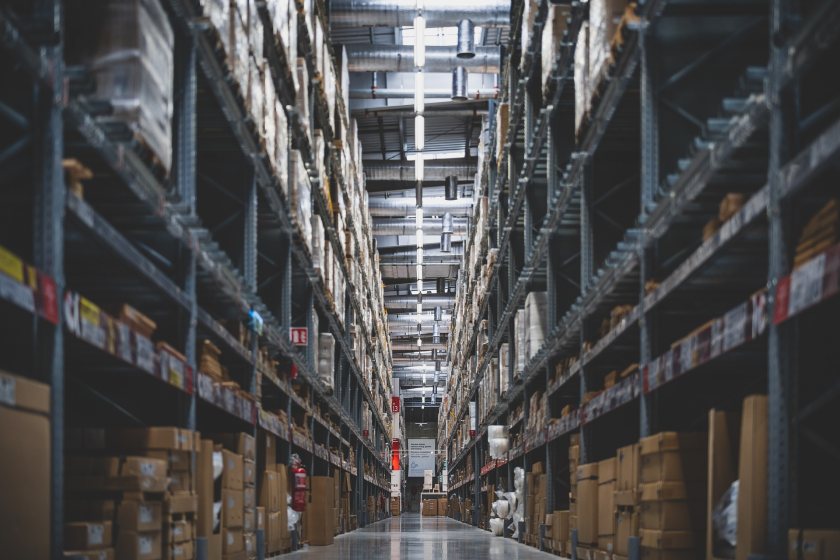
An industry expert has called for companies to leverage robots for smarter internal logistics, as the role of precise, adjustable motors can optimise warehouse processes.
Here, Dave Walsha, marketing director at drive system supplier EMS, explores how robotics could streamline internal logistics operations.
Over the last decade, the amount of transport, logistics and warehousing premises in the UK has almost doubled and the logistics industry currently employs approximately eight per cent of the UK’s workforce, according to Logistics UK.
With such a huge workforce and premises potentially spanning many locations, even the slightest disruption to the supply chain can have massive repercussions, as the last five years have shown.
Shaken by both Brexit and the COVID-19 pandemic, the UK logistics industry had to adapt to new trade regulations and extreme pressures to the global supply chain.
While external disruptions such as these might not be foreseeable, their impact can be minimised with efficient intralogistics.
Also referred to as internal logistics, intralogistics describes the management of the flow of goods within a given site, such as a warehouse or distribution centre.
Ensuring that processes such as the handling, movement and storage of goods are running smoothly inside the facility walls is crucial. However, this can prove challenging in such a fast-paced environment.
The logistics industry is currently suffering from a major shortage of skilled labour. A recent study by Descartes found that 37 per cent of supply chain and logistics leaders reported a high to extreme shortage of workers, while only five per cent reported no shortage at all.
With such a limited workforce, efficiency is of the essence as every second counts. Time-consuming, repetitive tasks such as order picking and packing, replenishing stock and sorting goods could be simplified with the aid of advanced robots.
For example, automated guided vehicles (AGVs) use a system of sensors, cameras and navigation technology to collect products and transport them to human workers for order packing.
With the aid of robots such as AGVs, the strain of workforce shortages eases and skilled workers have more time to respond to urgent or complex issues.
No task is more integral to efficient internal logistics than inventory management. Maintaining an accurate record of stock levels and where products are located on site is critical for getting customer orders processed and delivered on time.
Avoiding the financial losses from either stockouts or overstocking requires careful consideration that relies on strong visibility and organisation. The most efficient way to achieve this is through real-time tracking, aided by intelligent robots.
Manual inventory tracking is time-consuming and prone to inaccuracies due to frequent human error during the counting and scanning of products.
By contrast, automated tracking with sensor-equipped robots delivers more accurate data that is constantly updated in real-time, as autonomous robots can be programmed to complete continuous monitoring.
Fitted with barcode scanners or radio-frequency identification (RFID) readers, robots are also able to complete tracking tasks much faster than human workers.
Robots can also be designed with vision systems and mapping abilities to keep track of the location of stock throughout a site, resulting in better inventory management and storage efficiency.
Though robots have the potential to optimise internal logistics, many companies are hesitant to embrace them due to high upfront costs and performance concerns.
Due to the upfront investment in purchasing robots and their associated technologies, such as sensors and navigation systems, companies want to ensure that this expenditure will provide valuable returns.
To make logistics robots a worthwhile investment, robot engineers need to select appropriate, high-quality components to ensure robots can consistently perform demanding tasks.
For example, autonomous picking robots need to be able to handle a diverse range of products with care, using an exact amount of force to securely grip products without damaging them. Achieving such high precision and control comes down to the robot’s drive system.
Powered by 4-pole technology, brushless DC-servomotors from the FAULHABER BX4 series deliver high torque to facilitate the precise handling of products with different weights and sizes.
This technology also enables speed rigidity to ensure robots can operate at consistent speeds even when handling such varying loads.
Integrated motion controllers are also available for motors in this series, allowing for highly dynamic positioning with smooth motion control.
These controllers are designed to fit directly into drives with FAULHABER motors without the need for additional external control units, a distinct advantage for logistics robots which often have tight space requirements.
With the suitable drive system components, logistics robots can significantly improve operational efficiency. But how can a facility adapt to embrace automation?
Many logistics managers are concerned that ‘adjusting the sails’ may involve an extensive reconfiguration of their current setup, or even investing in an entirely new workflow.
However, this is not always the case. For instance, the modularity of FAULHABER drives allows robots to be customised to specific tasks, from handling delicate products to managing varying loads, all while maintaining consistent speed and torque.
The inclusion of integrated motion controllers streamlines robot control, minimising space requirements and ensuring smooth, dynamic movement — key for tight and complex logistics environments where floor space is premium.
As customers increasingly demand better product availability and faster delivery times, the logistics industry will need to adapt and consider new ways of moving products inside and outside the facility walls.
With the appropriate motor solutions, intralogistics can embrace automation to solve several of its bottlenecks.